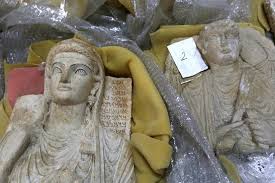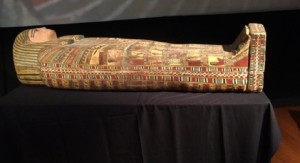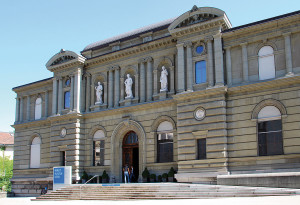by Amineddoleh & Associates LLC | Aug 21, 2015 |
 I am disturbed by Gary Vikan’s piece, “The Case For Buying Antiquities To Save Them.” What Mr. Vikan proposes is dangerous. Allowing museums to purchase antiquities to “save” them undermines the principles of due diligence aimed at excluding loot from museum collections. By allowing these institutions to accept or purchase unprovenanced antiquities, museums will increase the demand for illicit goods. Allowing irresponsible collecting practices creates a free pass for museums to acquire objects from war-torn regions. Where should we draw the line?
I am disturbed by Gary Vikan’s piece, “The Case For Buying Antiquities To Save Them.” What Mr. Vikan proposes is dangerous. Allowing museums to purchase antiquities to “save” them undermines the principles of due diligence aimed at excluding loot from museum collections. By allowing these institutions to accept or purchase unprovenanced antiquities, museums will increase the demand for illicit goods. Allowing irresponsible collecting practices creates a free pass for museums to acquire objects from war-torn regions. Where should we draw the line?
For decades, museums acquired illicit objects, and the system proposed by Mr. Vikan allows museums to openly do so. Trade in illicitly acquired artifacts is a demand-driven crime fueled by buyers. This is unacceptable; museums are the stewards of art and heritage and shouldn’t be contributing to the black market and incentivizing destruction.
And although Mr. Vikan questions whether antiquities fund ISIS, there has been a well-documented increase in the number of antiquities from Syria and Iraq traded on the international market. The massive increase in supply of antiquities from war-torn regions, as reported by US Customs, indicates that at least a significant portion of these objects were illegally excavated. The destruction of artifacts in the Middle East should not be used as an excuse for Western nations to acquire black market goods.
by Amineddoleh & Associates LLC | Apr 22, 2015 |
 I am happy to be featured in Kathleen Caulderwood’s excellent article, “U.S. Returns $2.5M in Egyptian Antiquities As Experts Call for Tougher Punishment on Smugglers.” The article emphasizes the importance of not purchasing illicit objects and examines some of the channels that prevent looted antiquities from being smuggled into the US.
I am happy to be featured in Kathleen Caulderwood’s excellent article, “U.S. Returns $2.5M in Egyptian Antiquities As Experts Call for Tougher Punishment on Smugglers.” The article emphasizes the importance of not purchasing illicit objects and examines some of the channels that prevent looted antiquities from being smuggled into the US.
by Amineddoleh & Associates LLC | Feb 23, 2015 |
Last winter, Leila Amineddoleh authored an article about Nazi-looted art, the Monuments Men, and the “Gurlitt Collection” for the NY State Bar Association. The piece examined legal issues related to the art objects in Cornelius Gurlitt’s collection of legally acquired, and looted, art, in addition to a broader examination of statute of limitations issues related to Nazi-loot. Leila’s article was updated twice due to advancements in the case.
 Last spring, after Mr. Gurlitt’s death, it was announced that he left his collection to the Kunstmuseum Bern. The museum was given six months to accept the gift. In November, mere days before the museum made its announcements, an estate issue arose. Uta Werner, Mr. Gurlitt’s 86-year-old cousin, applied to the Munich Probate Court for a certificate of inheritance for his estate, provoked by a psychological report concerning Mr. Gurlitt’s limited mental capacity at the time of the drafting of his will. The president of the German Forum for Inheritance Law noted that there were indications that Mr. Gurlitt was a “misfit” suffering from delusions. Ms. Werner has articulated that if she succeeds on her ownership claims, she intends to restitute Nazi-looted items to their rightful owners, as determined by a court. The Kunstmuseum Bern addressed the delay in a statement earlier this month,
Last spring, after Mr. Gurlitt’s death, it was announced that he left his collection to the Kunstmuseum Bern. The museum was given six months to accept the gift. In November, mere days before the museum made its announcements, an estate issue arose. Uta Werner, Mr. Gurlitt’s 86-year-old cousin, applied to the Munich Probate Court for a certificate of inheritance for his estate, provoked by a psychological report concerning Mr. Gurlitt’s limited mental capacity at the time of the drafting of his will. The president of the German Forum for Inheritance Law noted that there were indications that Mr. Gurlitt was a “misfit” suffering from delusions. Ms. Werner has articulated that if she succeeds on her ownership claims, she intends to restitute Nazi-looted items to their rightful owners, as determined by a court. The Kunstmuseum Bern addressed the delay in a statement earlier this month,
“At its last meeting, the Board of Trustees of the Kunstmuseum Bern categorically resolved that it will establish a “Gurlitt” research body and defined its tasks and structure. However, this decision can only first be implemented when the pending application of Cornelius Gurlitt’s cousin for a certificate of inheritance has been probated in Munich. The Board of Trustees regrets this delay, in particular because it will impede the settlement of restitution cases that have already been clarified and endorsed by the Kunstmuseum Bern, but the circumstances are beyond its control.”
In the meantime, representatives of the rightful owners are optimistic that restitution will begin before estate issues are resolved. Christopher Marinello, an attorney for the Rosenberg family (the family owned a Matisse painting in Gurlitt’s collection that Cornelius Gurlitt had agreed to return), expects “an expeditious restitution over the next few weeks.”
http://papers.ssrn.com/sol3/papers.cfm?abstract_id=2434205
 I am disturbed by Gary Vikan’s piece, “The Case For Buying Antiquities To Save Them.” What Mr. Vikan proposes is dangerous. Allowing museums to purchase antiquities to “save” them undermines the principles of due diligence aimed at excluding loot from museum collections. By allowing these institutions to accept or purchase unprovenanced antiquities, museums will increase the demand for illicit goods. Allowing irresponsible collecting practices creates a free pass for museums to acquire objects from war-torn regions. Where should we draw the line?
I am disturbed by Gary Vikan’s piece, “The Case For Buying Antiquities To Save Them.” What Mr. Vikan proposes is dangerous. Allowing museums to purchase antiquities to “save” them undermines the principles of due diligence aimed at excluding loot from museum collections. By allowing these institutions to accept or purchase unprovenanced antiquities, museums will increase the demand for illicit goods. Allowing irresponsible collecting practices creates a free pass for museums to acquire objects from war-torn regions. Where should we draw the line?
